Diner Mural at the Fulbridge Academy
July – Sept ’14

The Brief
Just over a year ago Iain Erskine, Principal at the Fulbridge Academy, set me a task to consider a design for a mural for the corridor leading to the Dining Hall. He asked if I could produce something with a ‘Healthy Eating’ theme which might influence the children as they lined up for their lunchtime meal. I mulled over a variety of ideas for several months while engaged with other projects before I found an idea I thought might work and then began developing the concept into something a little more tangible. I generated a series of drawings producing variations on the theme of transforming the corridor into an art exhibition.



The Design
My research entailed making a selection of paintings which would not only have ‘good food’ as its subject but which might also be appropriate as an learning resource, so to employ a broad timescale and include a variety of contrasting styles was very important. On the one hand the exhibition might present an introduction to Art History, but it could also present other opportunities too, suggesting possible openings to literary, political and general knowledge, as well as toward other genres such as music and film.

My selections for the exhibition was revised from one drawing to the next but eventually I made a commitment to a final choice and although I had expressed my idea verbally with Iain, at this time he had still seen none of my working drawings. We arranged to meet on 7th Feb and I laid out a cardboard model on the table in his office to show how I envisaged the corridor would appear. It would be transformed into an art exhibition comprising of 9 paintings, 1 Graphic print, 1 sculpture, 2 ‘graffiti’ images and a line of text, with an attendant in place guarding the artworks as one might find in an actual gallery situation.
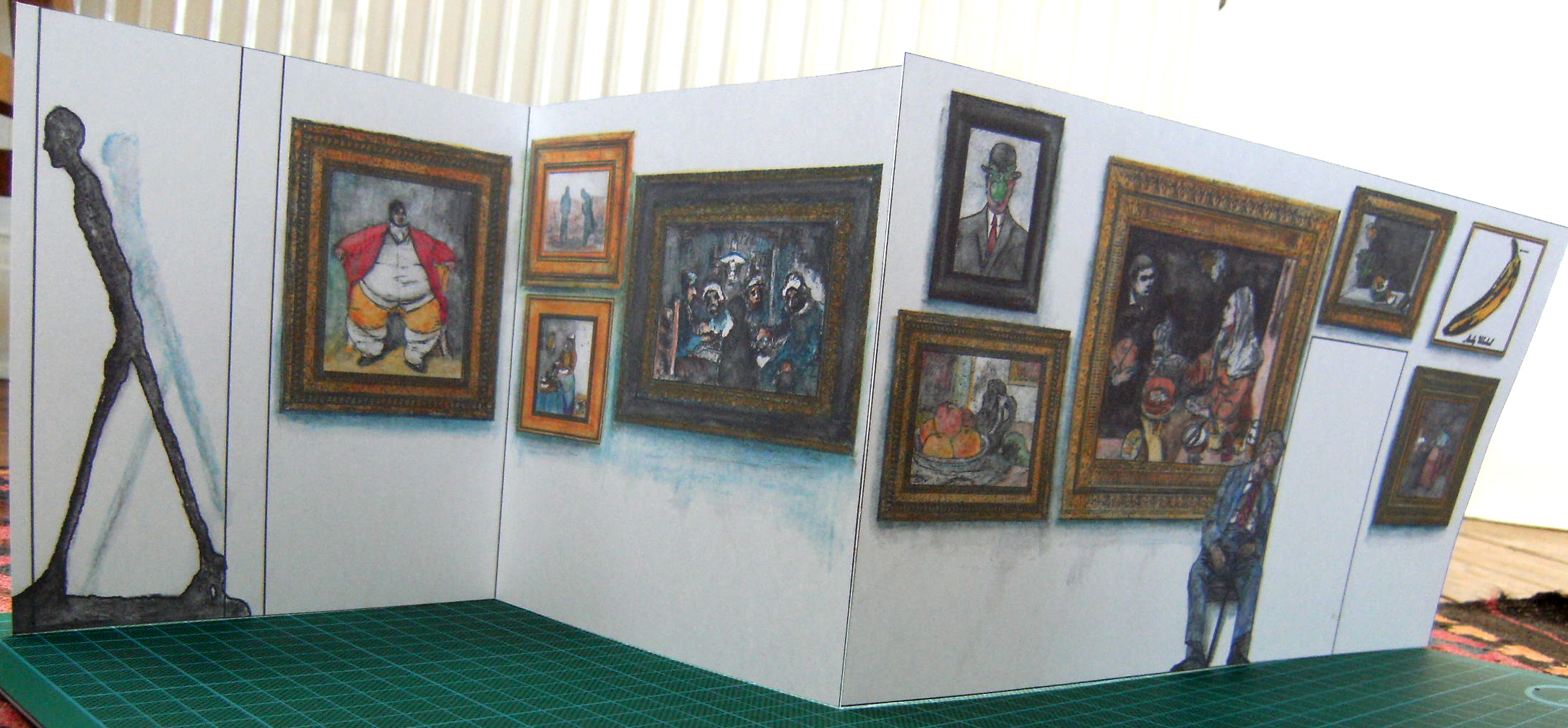
Iain was enthusiastic about the idea and the model was shown to several staff members and children as they passed by the office door to assess their reaction and opinion. With thumbs up approval, over the following weeks while still completing other large scale projects, I made further preparations in order that the idea on paper could be realised.
The Painting
At the beginning of July I began making the first marks on the wall and painted for the remainder of the month. As Iain likes the children to witness the painting process and the change taking place, rather than have it appear as though by magic, I took a break during August and resumed painting in September. It had been such a busy first half of the year, I was more than grateful for the rest!
Working on site in the corridor, the transformation of blank walls to Healthy Food Art Gallery took a total of 31 days to complete. My research, design development and preparation time is impossible to measure, but it was considerable. It would however have taken much less time had I not been so punctilious with my selection and layout – but as with all mural projects, it’s a permanent painting and on a monumental scale, and it had to be right.
I would describe the individual ‘exhibits’ as Souvenirs, a term I have ‘stolen’ from the Victorian artist Hercules Brabazon Brabazon (1821-1906), who used it to describe his lively and energetic watercolours and drawings produced as a result of working from the Masters. Notebooks form the backbone of my regular working practise and, like HBB, see personal interpretation of original compositions as an essential and beneficial learning experience.
It is not unusual for artists or composers to make interpretations of work that has touched them in some special way. It was an important working practise for Vincent Van Gogh and some of his finest works were translations of the work of others, about 20 of them being by another artist represented in this exhibition, Jean-François Millet. A part of my personal working practise I refer to as Souvenirs, paintings that have made a particular impression on me and which I admire. For the Diner project therefore, it was not my intention to make bad impressions of the work of others but rather to produce my own version of them.
With every image I had to get inside the head of the artist and I learned a great deal about how they worked and thought. Each was a challenge and without a shadow of a doubt the most difficult to paint was Vermeer’s ‘Milkmaid’. The man must have had the patience of a saint. There were times when I just wanted to scratch the plaster off the wall in frustration as I painted and repainted the pose of the figure time and time again. I strived in vain to achieve the same sensitivity in both poise and action. Millimetres made such drastic differences in the composition and these small discrepancies caused the figure to be devoid of her balance, control and grace as she pours the milk. Accuracy was key, there were no half measures. It was either right or it didn’t work at all. Vermeer was the hardest of task masters and very unforgiving. I tried my best but know this is the least successful of the group. All artists have their different skills but to rework Vermeer required some that I simply do not possess.
At the other end of the scale however, not counting Warhol’s ‘Banana’, Vincent was an absolute pleasure. Painting ‘The Potato Eaters’, a group of close knit working people enjoying their warm meal under the only light in their simple darkened room, was a complete contrast. The image appeared on the wall as though it was painting itself and any exaggerations, distortions or miscalculations didn’t alter the overall ‘feeling’ of the composition in comparison to the original at all.
The Corridor – Before & After




















The Artworks
Wall 4
Banksy – Caveman
Many children are already familiar with the work of Banksy, a graffiti artist and political activist. His work can employ both humour as well as a serious message. Further research would reveal many and various contemporary issues for debate.
The scale of this image is intimidating and can be seen the full length of the corridor.

Slatey – Oliver
My Banksy-esque ‘Oliver’ image works as a partner to the colossal Caveman. One of the most memorable lines of Charles Dickens’ ‘Oliver Twist’ (subtitled ‘The Parish Boy’s Progress’) is when Oliver holds out his empty bowl and asks ‘Please, sir, I want some more.’ In a ‘twist’ to the original, my Oliver holds forth a bowl of healthy, colourful fruit instead, incidentally ‘stolen’ from ‘Still Life with Crystal Bowl’ by the Pop Artist Roy Lichenstein. The image could be an introduction to the chapter in the Dickens novel which describes the dining hall of the workhouse and the diet presented to the boys in the workhouse, the 1948 ‘Oliver Twist’ David Lean film or even the musical drama directed by Carol Reed from 1968.
Wall 1
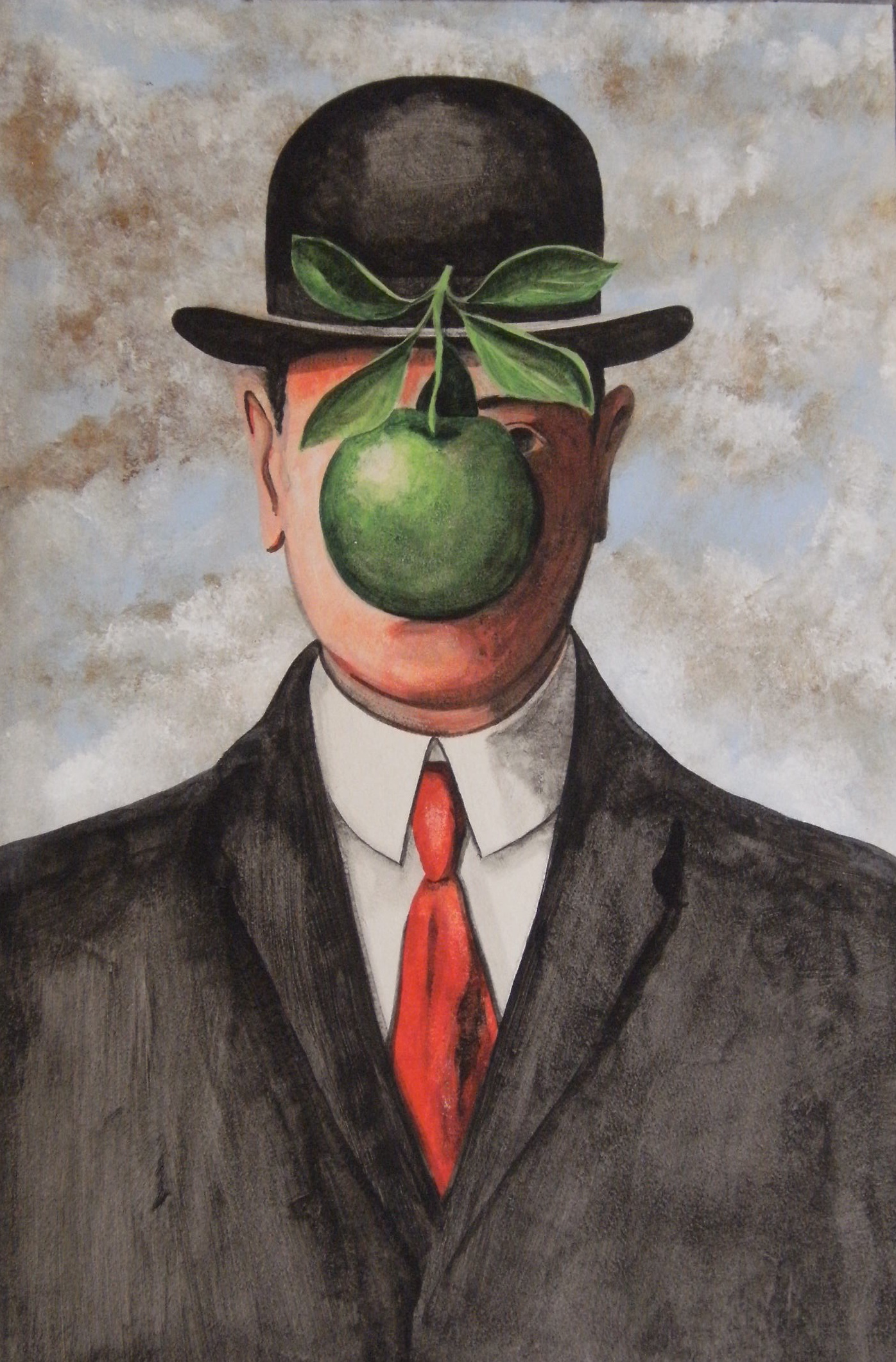
Magritte – The Son of Man
Photographs of the surrealist artist René Magritte often show him dressed in a black suit and tie wearing a bowler hat, and this was painted as a self portrait.
The Surrealists presented the world as a place of dream and fantasy where conventional rules of logic and reason no longer applied. In this case the apple could be simply a mask such as many of us hide behind when we present ourselves in public. The apple is also a symbol of temptation and often appears as a mystical or forbidden fruit. It’s certainly an image to provoke discussion and an introduction to the world of the Surrealists, which developed at the end of the First World War. The worlds of Sigmund Freud, Guillaume Apollinaire, André Breton, Ernst, Dali, De Chirico, Duchamp and Buñuel are but a mere step from here.
I find it interesting that the cartoonist Hergé, who is also Belgian, illustrated the incompetent detectives Thomson and Thompson in the adventures of Tin Tin wearing the same attire as Magritte.

Gauguin – Still Life with Apples, a Pear and a Ceramic Portrait Jug
Perhaps the first name which comes to mind when looking at a still life painting with fruit would be Cezanne and it has caused me serious disquiet that I didn’t include him. He was the bridge between the Impressionist era and the radical modern movements of the twentieth century. His work opened the door to Cubism and profoundly influenced the direction of modern art.
It was a tough decision to omit such an influential figure (one which I’m still not certain I got right) but I decided to include this still life by Paul Gauguin instead. Gauguin is not only included for his association with Vincent but because of his influence upon the direction of art in the twentieth century, and also to establish a link with ceramic art which is one of the oldest arts practices. The earliest evidence of the use of pottery dates back 20,000 years and Gauguin was one of many artists, such as Daumier and Picasso, who worked with clay as well as the more familiar medium with which they are better known.
In this composition Gauguin includes a ceramic portrait jug and a similar ‘self portrait’ jug, also referred to as a ‘severed head’, is well documented. During his time in Tahiti Gauguin produced large figure paintings as well as ceramic works which had a powerful impact on Picasso. One piece, Oviri made in 1894, stimulated particular interest. This knowledge of the art of Oceania via Gauguin, and his interest in African tribal masks, were to influence the development of his painting Les Demoiselles d’Avignon in 1907.
This landmark painting was both revolutionary and controversial as known form and representation was completely abandoned, and is widely considered as the piece which sparked the beginning of the Modern era.

Velάzquez – Old Woman Cooking Eggs
I have a long list of favourite painters and the name of Diego Velάzquez would be high on that list. A few years ago I was fortunate to be able to spend a long weekend in Madrid where I visited the Prado and fulfilled an ambition see the black paintings of Francisco Goya and to stand in front of the magnificent ‘Las Meninas’. Fortunately this masterpiece ‘An Old Woman Cooking Eggs’ is closer to home and can be found in the National Gallery of Scotland in Edinburgh.
It is difficult to believe that Velάzquez painted this picture when he was only 18 or 19 years old, he was already so remarkably skilled in the accurate reproduction of the different textures and surfaces in this composition that it is almost photographic.
A simple meal is being prepared and like many of his early works it demonstrates the influence of chiaroscuro, a dramatic lighting effect which was exploited by both Velάzquez and Caravaggio.
With the other paintings in this project I was not concerned with reproducing my interpretations the same size as their counterparts, however as I had the opportunity to work on such a large wall I wanted the size of my souvenir of Velάzquez to be as close as possible to the original. I also placed it alongside the still life by Cotán as it had a similar appearance to a bodegόn, with the various elements in a line and having such a dark background. Like many still life paintings there may be a degree of symbolism with respect to the transient qualities inherent in the composition, but this is speculation. The two characters appear in other paintings produced by Velάzquez at this time, the old woman (and the mortar and pestle) in ‘Christ in the House of Martha and Mary’, and the young boy in ‘The Waterseller of Seville’.
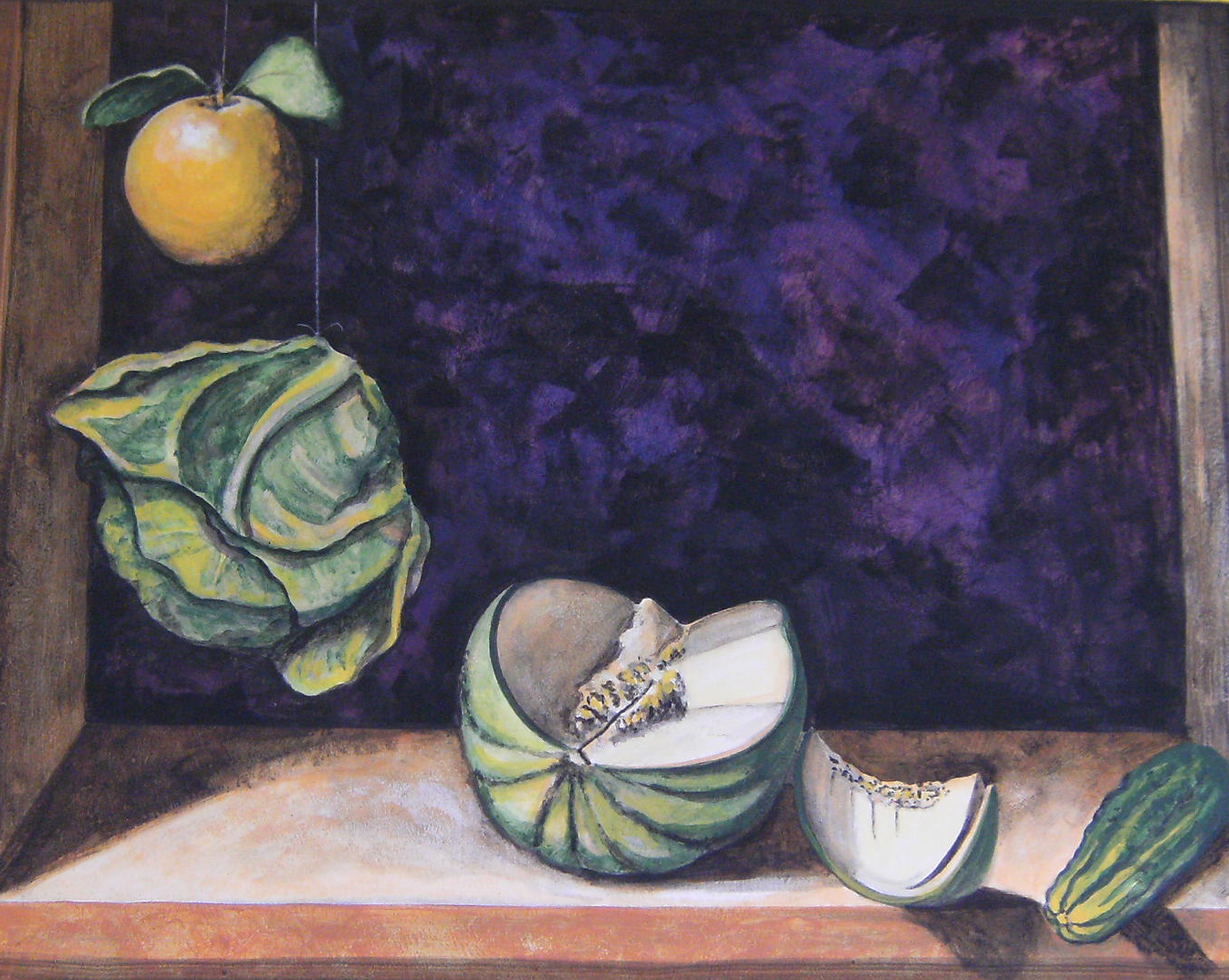
Cotán – Quince, Cabbage, Melon and Cucumber
Juan Sánchez Cotán established the style of Spanish still life called a bodegón, which is often composed mainly of vegetables. The tradition of still life painting has been very popular for many centuries, classic trompe l’oeil presentations of fruit was common in ancient Rome. Some believe still life painting to be merely a straightforward depiction while others consider it to have have much deeper significance.
Although not in this example, still life paintings may include the word Vanitas in their title, suggesting the work is symbolic of the transient nature of all earthly goods and pursuits. The precise, mysterious and accurately observed work of Cotán, with deep black nothingness in the background, may even have religious overtones. He walked away from the world to spend the rest of his life in a Carthusian monastery after painting this picture.
http://www.youtube.com/watch?v=-ZsAwhgM1wc
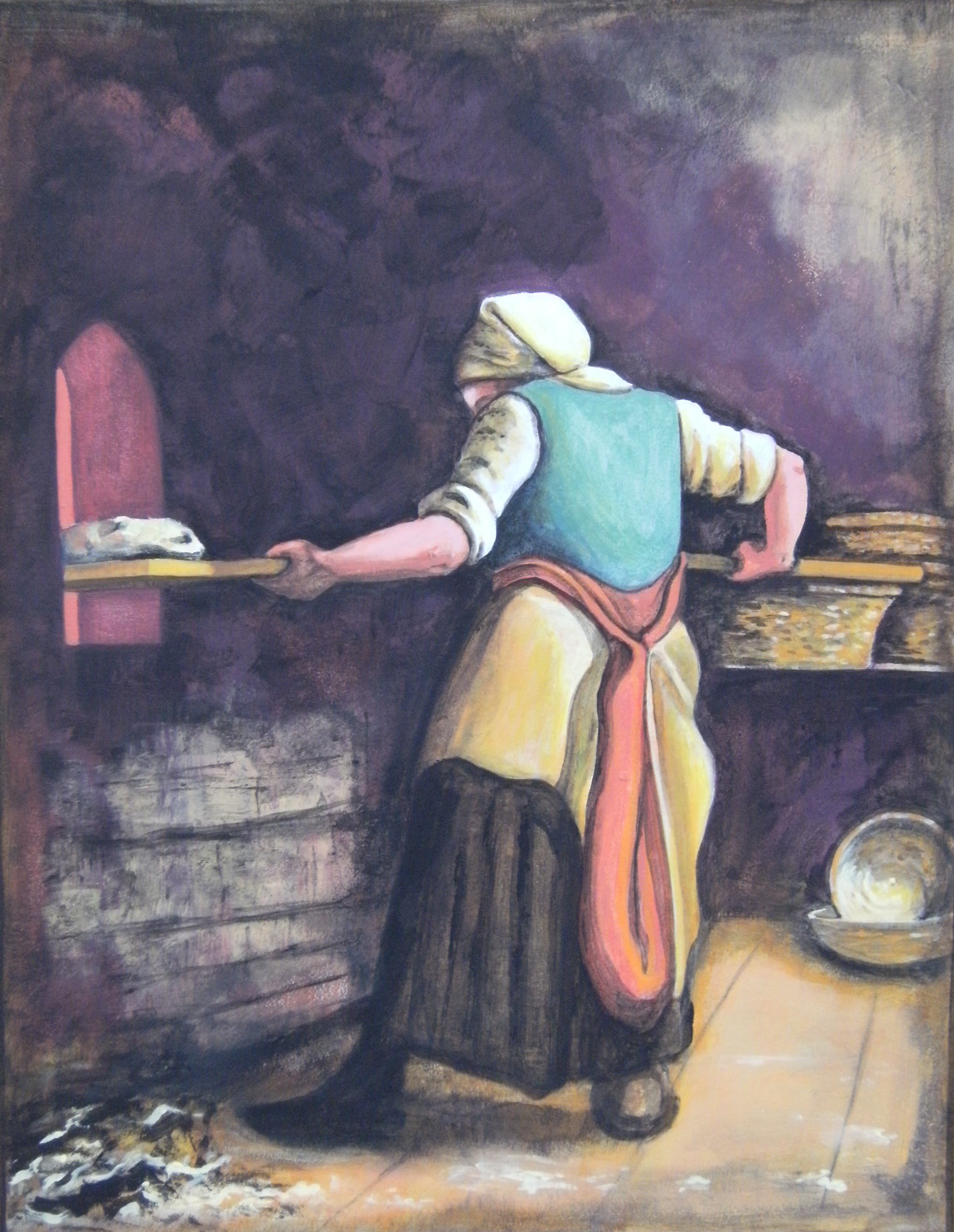
Millet – Woman Baking Bread
There are two paintings after Millet that are included as souvenirs and this one, of a Woman Baking Bread, looks very much like the now more familiar sight of baking a pizza.
I chose this image for its link with another work Vincent copied after Millet, The Sower. After sowing the seed and harvesting the corn, next is the making of the bread, one of the oldest prepared foods and the forth of the seven petitions in the Lord’s Prayer – Give us this day our daily bread.
Millet’s modest background had a great influence on the subject matter of his works. ‘I was born as a peasant and shall die as a peasant’, Millet once said. Millet’s works are a nostalgic tribute to farmers and labourers, he felt great compassion for people who worked the soil with their own hands and it is here that Van Gogh and Millet connect.
‘I say again — Millet is — PÈRE Millet, that is, counsellor and guide in everything, for the younger painters’. Letter from Vincent to Theo. Nuenen, Monday 13 April 1885.

Warhol – Banana
Easily the most straightforward souvenir to paint was the illustration of a banana by Andy Warhol. A leading figure in the Pop Art visual art movement, Warhol was interested in American popular culture and as well as painting used silkscreen and other reproductive processes. He made paintings based on newspaper title pages, advertisements and other mass-produced images, and used silkscreen for a series of paintings of ‘Campbell’s Soup Cans’, ‘Coca-Cola Bottles’, portraits of Marilyn Monroe, Elizabeth Taylor, Elvis Presley, Jackie Kennedy, and later also car crashes, the electric chair, flowers etc, sometimes with rows of repeated images.
This image is taken from the The Velvet Underground & Nico’s debut album released in 1967, which was printed as a sticker and when peeled back revealed a ‘nude’ flesh coloured banana underneath.
Wall 2

Millet – The Angelus
The Angelus refers to a Catholic devotion commemorating the Incarnation but its original title was ‘Prayer for the Potato Crop’ and is a typical example of the work of Jean-Francois Millet. The planting and harvest of crops and the hard life endured by peasant farmers in nineteenth century rural France was a favourite subject. The labour demanded to provide food illustrated the delicate balance between success and failure and an important reminder of where food actually comes from.
Millet was a source of inspiration for Vincent Van Gogh, as were other painters whose subject celebrated the work of the countryside such as Herkomer and Lhermitte, and he mentioned this painting by name in a letter to his brother Theo in January 1874 ‘Yes, that painting by Millet ‘The evening angelus’ that’s it. That’s rich, that’s poetry.’
The Surrealist artist Salvador Dali was fascinated by this work and was convinced the couple were praying over their dead child rather than to the Angelus. An x-ray may have revealed Dali to be right as it was found that the basket of potatoes was painted over a geometric shape similar to that of a coffin, which suggests that Millet may have changed his mind about the meaning in the painting.
http://www.youtube.com/watch?v=3KjZ3w5MtBo
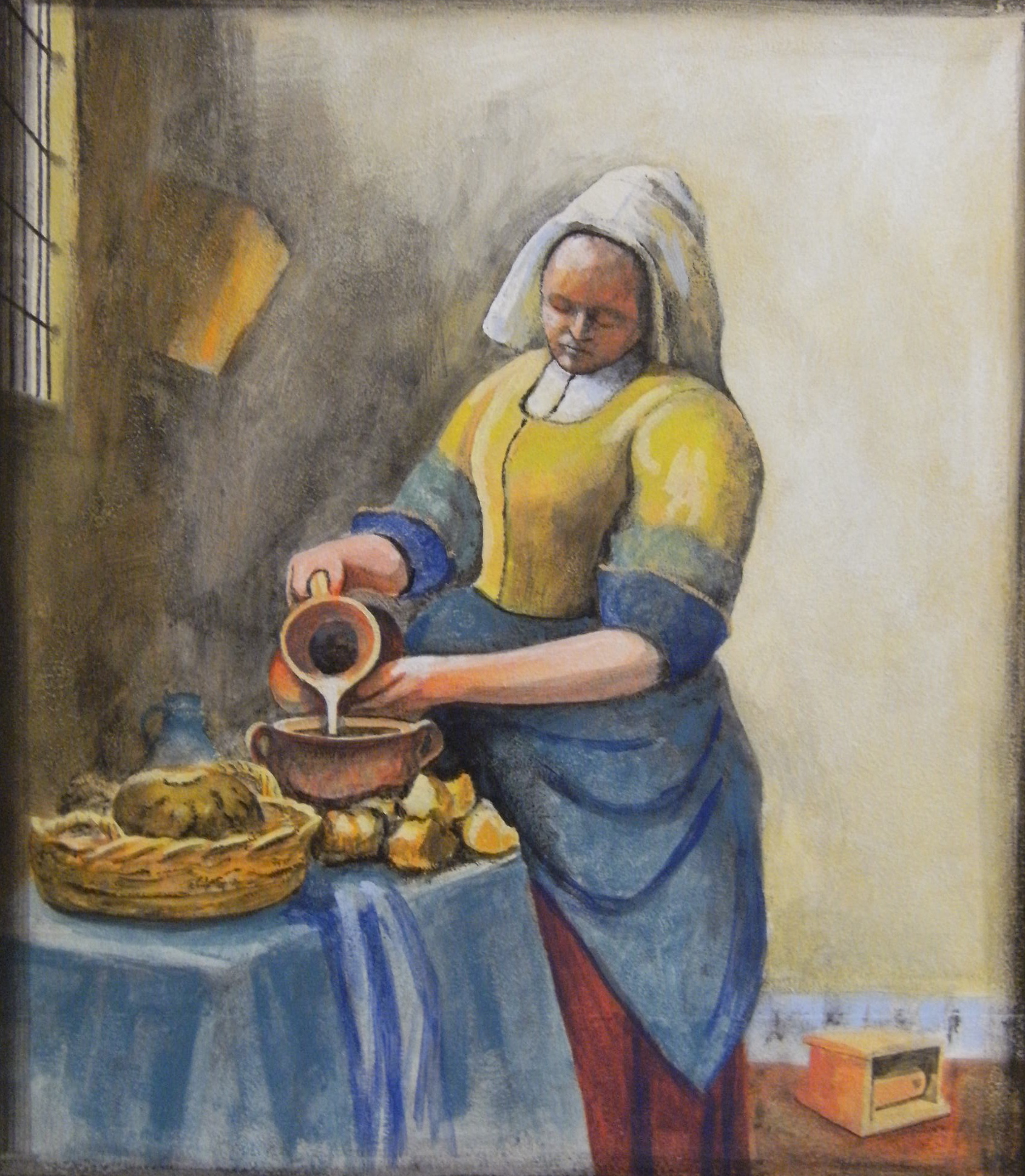
Vermeer – The Milkmaid
By far the most difficult souvenir to paint was this beautiful contemplative painting of The Milkmaid by Johannes Vermeer. She appears lost in her thoughts as she carefully pours milk from a jug into an earthenware bowl.
The humility and concentration captured in this composition makes a deeply poetic statement about the life and routine of a domestic servant in seventeenth century Delft. Tracy Chevalier described this world in her 1999 novel Girl With a Pearl Earring which was adapted into a film in 2003 starring Scarlett Johansson and Colin Firth.
http://www.youtube.com/watch?v=LncjJzgrKfA
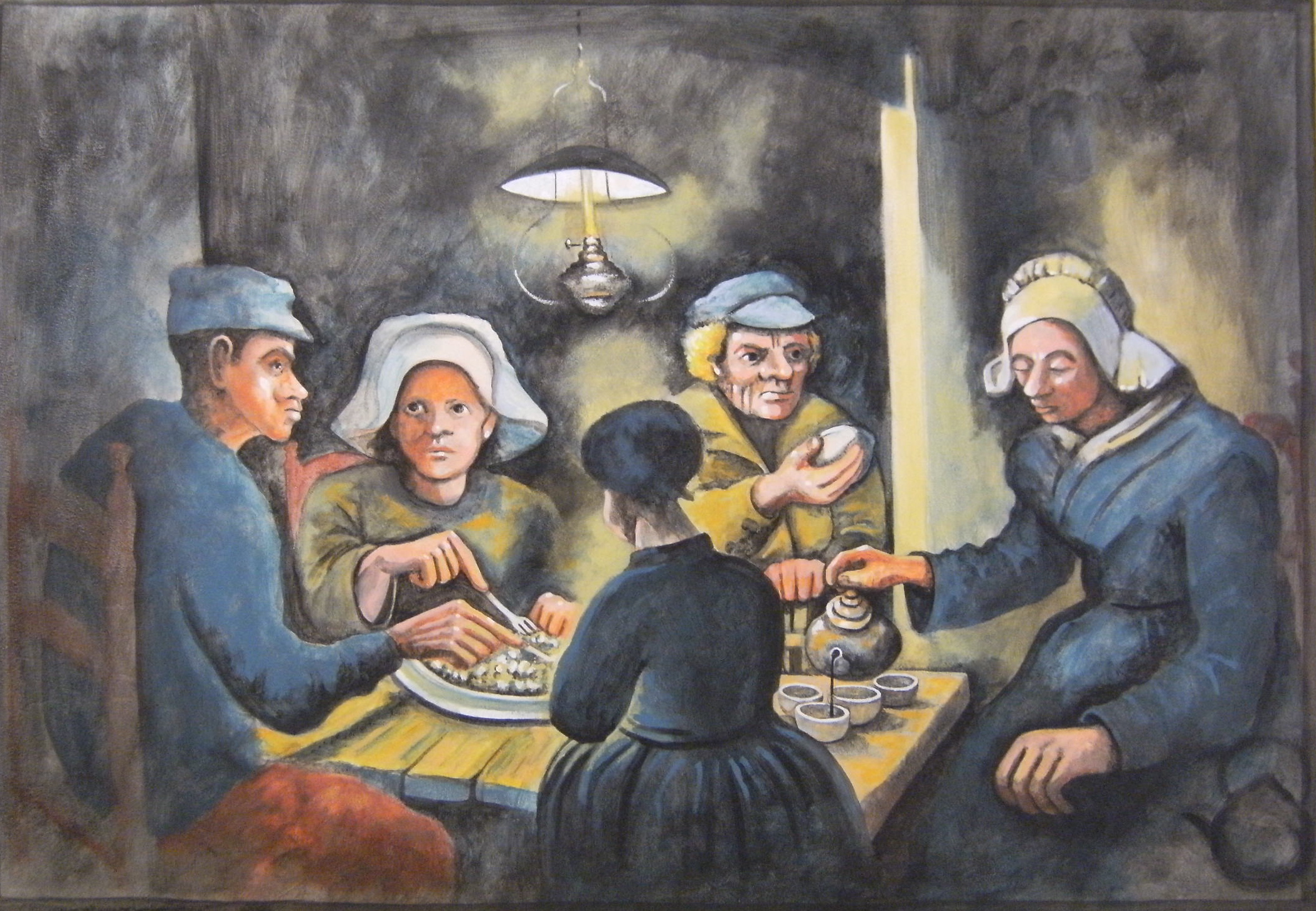
Van Gogh – The Potato Eaters
Although the composition is loyal to the original, my Potato Eaters is much brighter.
This painting made a big impression on me when I began at art school. I remember reading references to it in the letters he wrote to his brother Theo and comparing the many drawings and painted sketches leading toward the final composition.
‘You see, I really have wanted to make it so that people get the idea that these folk, who are eating their potatoes by the light of their little lamp, have tilled the earth themselves with these hands they are putting in the dish, and so it speaks of manual labour and — that they have thus honestly earned their food. I wanted it to give the idea of a wholly different way of life from ours — civilized people. So I certainly don’t want everyone just to admire it or approve of it without knowing why.’ Letter from Vincent to Theo. Nuenen, Thursday, 30 April 1885
It was also at this time that I read the Irving Stone novel ‘Lust for Life’ for the first time. His graphic prose describes how the Potato Eaters may have been created and the scene is portrayed in the film of the same name, with Kirk Douglas as Vincent in a role he was born for.
Wall 3
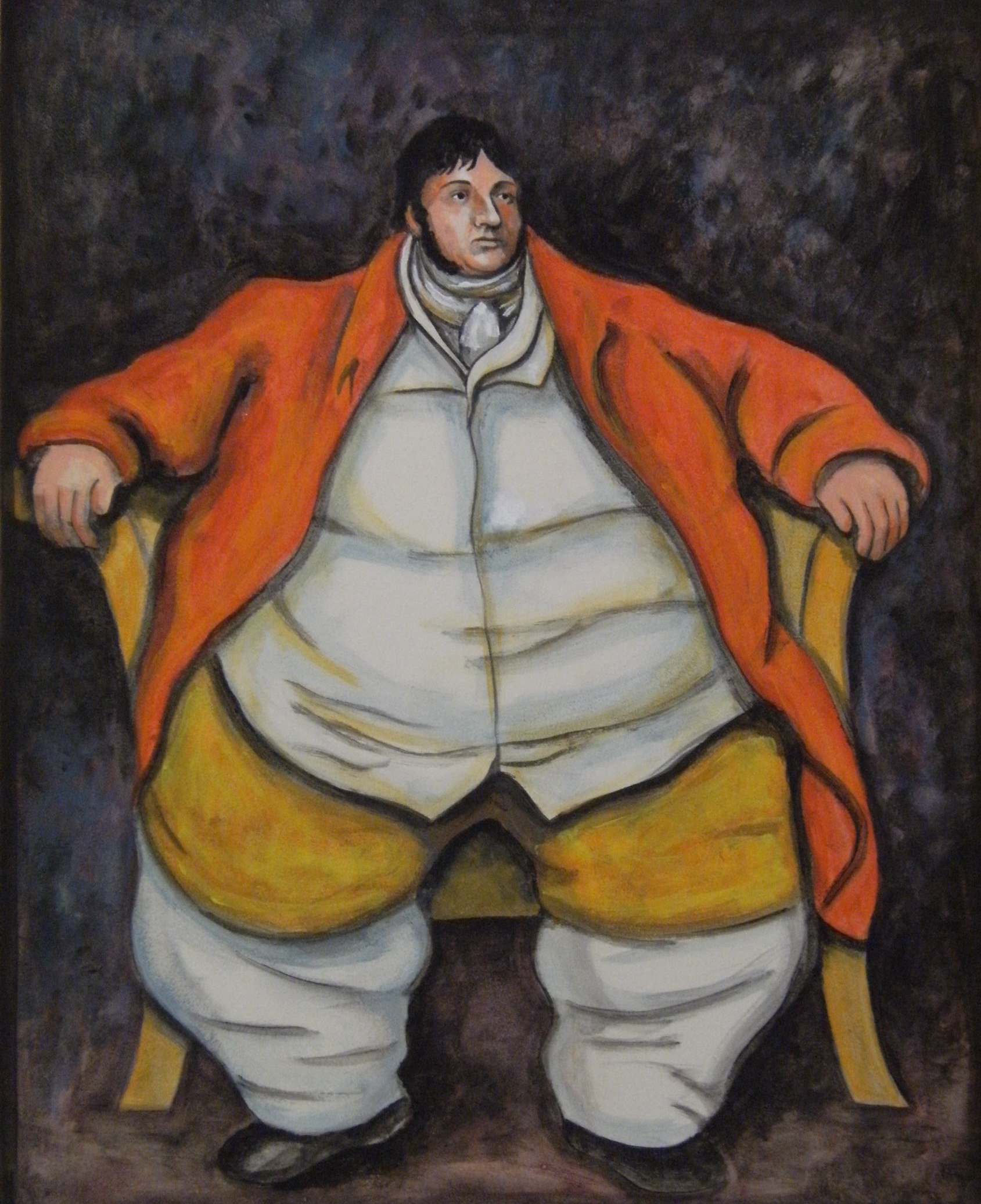
Benjamin Marshall – Daniel Lambert
With the subject of the painting being ‘Healthy Eating’, I decided I would include references to both over and under indulgence too which might act as a trigger for discussion.
As far as over indulgence was concerned I decided to use a local personality as an example as his life has been so well documented, and my souvenir is based upon A Portrait of Daniel Lambert painted by Benjamin Marshall in 1806. Lambert is buried in St Martin’s Churchyard, High Street, Stamford and Stamford AFC, ‘The Daniels’, are nicknamed after him.
When he died Lambert weighed 52 stone, his size very unusual for the early nineteenth century. The most likely cause however was over eating and lack of exercise.
http://www.youtube.com/watch?v=A-JZOSPkubg

Giacometti – L’Homme qui marche
My original choice for an under-eating image was to be Picasso’s ‘Frugal Meal’ with its under weight figures, but there’s a big difference between having no food and preferring not to eat.
I’ve always admired the work of Swiss artist Alberto Giacometti, whether it be his drawing, painting or sculpture. With his ‘Walking Man’ I had the perfect excuse to include the most expensive piece of sculpture ever sold when it was auctioned by Sotheby’s in 2010 and an artist it is impossible to pigeon hole, which brings the opportunity to introduce the concept of Existentialism with which Giacometti has been associated.
A dictionary definition clarifies the term as ‘a philosophical theory or approach that emphasises the existence of the individual person as a free and responsible agent determining their own development through acts of the will’ and there are many individuals who are difficult to categorise, whether they are adults or still of school age.
To gain an understanding of Existentialism, examples of can be recognised in the cinema, in films such as Ikiru, Taxi Driver, Easy Rider, One Flew Over the Cuckoo’s Nest, A Clockwork Orange, Groundhog Day, where characters act independently of the world around them.

Sleeping Artist Self Portrait
There was much debate about the sleeping figure. In my original design I had drawn a sleeping gallery attendant but suggested to Iain that I also had in mind that this figure could be a sleeping Head Teacher or Principal. Iain however preferred that it should be a portrait of me at rest after my toil.
As all the other ingredients of the painting have an art historical reference I naturally wanted this to have one too, therefore the pose I adopted was important. However, as it also had to work in relation to the doorpost I was supposedly leaning up against it had to be modified a little. The pose is taken from the painting ‘Worn Out’ (1868) by Scottish painter Thomas Faed. Although it is not a well known piece it was especially admired by none other than Vincent Van Gogh and was mentioned in one of his many letters to his brother Theo.
Rather than being separate this element is therefore connected with the rest of the composition and as I worked from a photographic reference works as a possible introduction to both Photo Realism as well as to Oscar Wilde. This could be me as Dorian Gray. For all one knows, I might no longer age – but this painted version might!

The Times – 19 September 2015
Fulbridge Academy, Keeton Rd, Peterborough PE1 3JQ
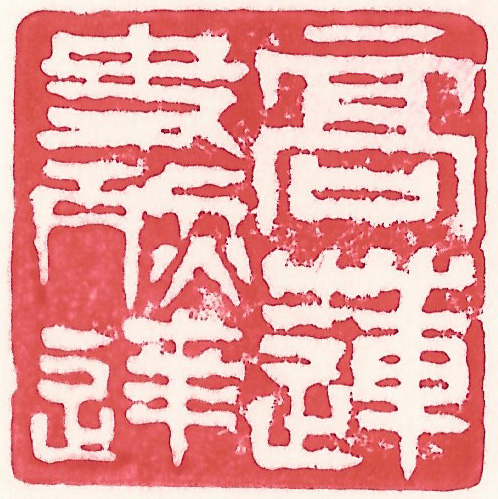
Leave a Reply